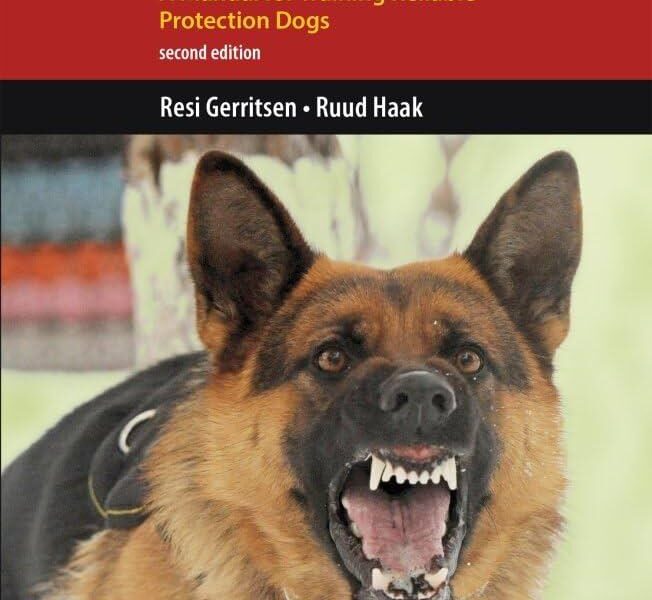In a world where safety and security have become paramount, the role of K9 protection has emerged as a vital asset in safeguarding lives and assets. Beyond mere companionship, these highly-trained canine protectors epitomize loyalty, intelligence, and an acute sense of awareness that humans often lack. From law enforcement agencies utilizing skilled police dogs to protect their communities, to private security firms employing specialized breeds for personal and commercial protection, the impact of K9 units is profound and far-reaching. This article explores the fascinating realm of K9 protection, delving into the training, roles, and undeniable bond between humans and their four-legged guardians—shedding light on how these remarkable animals transcend the boundaries of traditional security concepts. Join us as we uncover the essential contributions of K9 teams in fostering safety and trust in an unpredictable world.
Table of Contents
- The Evolution of K9 Protection: From Military to Everyday Life
- Understanding the Role of K9 Units in Public Safety and Community Engagement
- Choosing the Right K9: Breeds, Training, and Temperament Considerations
- Integrating K9 Protection into Your Security Strategy: Best Practices and Tips
- Q&A
- Key Takeaways
The Evolution of K9 Protection: From Military to Everyday Life
The journey of K9 protection has advanced significantly over the decades, transitioning from very specialized military and law enforcement applications to a widespread presence in civilian life. Historically, the connection between humans and dogs in a protective capacity can be traced back to ancient civilizations, where dogs were utilized for guarding settlements and herding livestock. The modern era saw a formalization of this bond, particularly during World War I and II, when dogs were trained for specific roles such as search and rescue, detecting mines, and providing protection to troops. Today, the use of K9 units has expanded beyond the battlefield, influencing various sectors, including:
- Personal Security: Many individuals now employ protection dogs for their personal safety.
- Law Enforcement: Police departments depend on K9 units for drug detection, crowd control, and tracking.
- Search and Rescue: Specialized dogs assist in locating lost persons in various terrains.
- Therapeutic Support: Emotional support and therapy dogs are increasingly recognized for their calming effects.
This evolution is not just a trend but rather a deeper understanding of the unique capabilities that canines bring to human safety and companionship. As society has become more aware of the potential benefits of K9 protection, the training methods and breeds utilized have also adapted. Organizations are now focusing on breeding for specific traits, behaviors, and temperaments that suit various roles in everyday life. Furthermore, the integration of advanced technology in training and monitoring has heightened the effectiveness of K9 units, creating a synergy where canine instincts and human oversight work hand-in-hand. the journey from military to civilian use has not diminished the importance of K9s; it has revolutionized how we understand and implement their protective roles.
Understanding the Role of K9 Units in Public Safety and Community Engagement
K9 units play a fundamental role in enhancing public safety by employing the unique abilities of highly trained dogs to assist law enforcement agencies. These remarkable animals are not only adept at detecting narcotics and explosives, but they also contribute to crowd control and search-and-rescue operations. The bond between K9 handlers and their dogs is crucial as it fosters a level of trust and communication that enhances operational effectiveness. Some key functions of K9 units include:
- Detection of contraband: Dogs possess an exceptional sense of smell, allowing them to locate illegal substances and weapons with high accuracy.
- Tracking missing persons: K9s have the ability to track scents over long distances, aiding in locating lost individuals.
- Public demonstrations: K9 units engage in community outreach through public demonstrations that showcase their skills and educate the public.
In addition to their operational roles, K9 units are pivotal in fostering community engagement. They act as a bridge between law enforcement and the public, promoting a sense of safety and partnership. The interaction between K9s and community members during school visits, community events, and safety fairs creates opportunities for positive dialogues. Below is a simplified overview of the community engagement methods employed by K9 units:
| Engagement Method | Description |
|---|---|
| School Programs | Visits to schools to educate children about safety and the role of K9 units. |
| Community Events | Participation in local fairs and events to demonstrate skills and promote safety awareness. |
| Public Safety Workshops | Organizing workshops to teach the public about crime prevention and the importance of K9 support. |
Choosing the Right K9: Breeds, Training, and Temperament Considerations
Selecting the right canine for protection duties is crucial and should be approached with careful consideration of various factors. Different breeds possess distinct traits, making them more suitable for specific environments and tasks. Some of the most popular breeds for protection include:
- German Shepherd: Known for their intelligence and loyalty, they excel in training and are often used in police and military roles.
- Belgian Malinois: Highly energetic and agile, these dogs are beloved in protection roles and require vigorous physical training.
- Rottweiler: With their strength and protective instincts, Rottweilers are often employed as guard dogs.
- Doberman Pinscher: Intelligent and alert, they offer both companionship and protection with the right training.
Beyond breed selection, training is an instrumental factor that shapes a dog’s protective capabilities. Training strategies should include:
- Basic Obedience Training: Establishes a foundation for good behavior and reliable commands.
- Socialization: Exposes the dog to various situations, preventing fearfulness and ensuring control in diverse environments.
- Protection Training: Teaches the dog how to respond to threats while fostering their natural protective instincts.
Additionally, a dog’s temperament—its natural disposition towards humans and other animals—plays a significant role. Look for traits like:
- Confidence: A confident dog is less likely to feel threatened.
- Trustworthiness: Essential for forming strong bonds with family members.
- Adaptability: The ability to adjust to new situations is invaluable in protection scenarios.
Integrating K9 Protection into Your Security Strategy: Best Practices and Tips
Incorporating K9 protection into your security framework requires careful planning and execution. To maximize effectiveness, consider the following best practices:
- Assess Your Environment: Evaluate the unique security needs of your facility or event. Understanding the specific risks will help tailor your K9 strategy.
- Select the Right Breeds: Different breeds excel in various roles—protection, detection, or search and rescue. Choose a breed that fits your operational requirements.
- Training Protocols: Regularly update and maintain training schedules for both the K9s and handlers to ensure they can adapt to evolving threats.
- Team Integration: Foster collaboration between your human security staff and K9 teams. This synergy enhances overall response strategies and operational efficiency.
Effective communication and transparency are vital when integrating K9s into a security strategy. Consider implementing a comprehensive feedback loop to continuously improve the deployment of K9 units. Here’s a simple table to illustrate key performance indicators (KPIs) you can monitor:
| KPI | Description | Target Value |
|---|---|---|
| Response Time | Time taken to deploy K9 units in case of an incident. | Under 5 minutes |
| Training Hours | Monthly hours spent on K9 and handler training sessions. | 20 hours |
| Incident Resolution Rate | Percentage of incidents resolved with K9 assistance. | 90%+ |
Q&A
Q&A: Understanding K9 Protection
Q1: What is K9 protection and how does it work?
A: K9 protection refers to the use of specially trained dogs to assist in safeguarding individuals, property, or sensitive locations. These dogs undergo rigorous training to detect threats, provide physical protection, and respond effectively to various security scenarios. Their keen senses and loyalty make them essential partners in the realm of security.
Q2: What types of dogs are typically used in K9 protection?
A: Breeds that excel in K9 protection often include German Shepherds, Belgian Malinois, Rottweilers, and Dutch Shepherds. These breeds are known for their intelligence, agility, and strong work ethic, all vital traits for effective protection work.
Q3: What kind of training do K9 protection dogs undergo?
A: Training for K9 protection dogs encompasses obedience, agility, and specialized skills such as protection techniques, scent detection, and situational awareness. Often, this training is conducted in both controlled environments and real-life scenarios to prepare the dogs for various challenges they might encounter on duty.
Q4: Who handles K9 protection dogs during their work?
A: K9 protection dogs are typically partnered with law enforcement officers, private security personnel, or specialized K9 handlers. The bond between the handler and dog is critical, as effective communication and trust enhance the unit’s overall performance and success in protection tasks.
Q5: In what situations are K9 protection teams deployed?
A: K9 protection teams are deployed in various situations, including public events, high-profile security details, and searches for narcotics or explosives. They also play a crucial role in crowd control and can be used in apprehending suspects when necessary.
Q6: How do K9 dogs differentiate between threats and non-threats?
A: K9s utilize their exceptional senses to detect subtle changes in their environment that may indicate a threat. Through training, they learn to assess body language and human behavior, helping them discern between friendly interactions and potential dangers. Their instincts and training ensure that they are reliable in varied scenarios.
Q7: Are there ethical considerations surrounding K9 protection?
A: Absolutely. Ethical considerations in K9 protection include the welfare of the animals, ensuring they are treated humanely, and prioritizing their health. Additionally, K9 handlers must be trained to recognize when to deploy their dogs and when to avoid unnecessary escalation, balancing security needs with responsible handling.
Q8: What benefits do K9 protection teams provide over traditional security methods?
A: K9 protection teams offer several benefits, including enhanced detection capabilities, the psychological deterrent of a canine presence, and rapid response times. Their ability to sense threats that humans might miss provides an additional layer of security that is often invaluable in protecting people and property.
Q9: How can one become a K9 handler?
A: Becoming a K9 handler typically involves a background in law enforcement or security. Interested individuals usually undergo specialized training programs that focus on canine behavior, training methods, and operational procedures. Building a strong bond with the dog and maintaining ongoing training is key to a successful partnership.
Q10: What is the future of K9 protection in security?
A: The future of K9 protection looks promising as technology and training methods continue to evolve. Integration with advanced surveillance systems, improved training techniques, and more extensive public awareness are likely to enhance the effectiveness of K9 units, making them an even more critical asset in modern security operations.
Key Takeaways
In wrapping up our exploration of K9 protection, it becomes clear that the bond between humans and their four-legged guardians transcends mere duty. These remarkable dogs, equipped with extraordinary senses and unwavering loyalty, serve as both protectors and partners. From law enforcement agencies to personal security details, K9s embody a unique blend of instinctual prowess and extensive training, ensuring the safety and well-being of those they serve.
As we reflect on the role of these canine companions, it’s important to recognize the profound impact they have on our communities. They not only deter potential threats but also foster an unparalleled sense of comfort and trust. The advancements in training techniques and technologies promise an even brighter future for K9 protection, as we continue to harness their abilities to safeguard lives.
In the ever-evolving landscape of security, K9 units stand as a testament to the enduring partnership between humans and animals, a relationship built on mutual respect and unwavering commitment. As we look ahead, we celebrate the unsung heroes in fur coats, for they are not just dogs; they are protectors, loyal friends, and vital members of our safety teams. Let us continue to honor their contributions and the invaluable role they play in fostering safer communities for us all.


